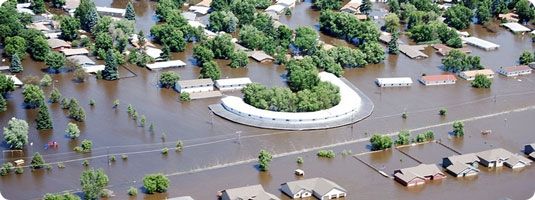Getting Heads Above Water in North Dakota

The Souris River is back in its banks, but the oncoming winter freeze could potentially cause further damage in flood-ravaged Minot, North Dakota. This past June, the city experienced the worst flooding in a century.
“The river’s down, now, and some of the dikes have been removed for road access,” said the Rev. John Floberg, Canon for Multicultural and Central Area Ministries and Diocesan Disaster Coordinator for the Episcopal Diocese of North Dakota. “But they’re keeping the others in place for next spring. It’s not that far away.”
The ground in and around Minot has been saturated since the spring of 2011, when winter precipitation in the state and further west began to melt. Flooding started in April, around the Red River of the North, the Assiniboine, and the Missouri and Mississippi Rivers. The Souris River, which runs through the city of Minot, is a tributary of the Assiniboine, which dips down into North Dakota from Canada. Flood-prone areas of Minot were evacuated twice: once on June 1, and a second time on June 22, just before the river reached record flood levels, spilling over dikes and inundating homes and businesses. Nearly 12,000 people were evacuated the second time; Canon Floberg estimates that the homes of a quarter of Minot’s population were underwater.
In response, Episcopal Relief & Development will be supporting the Diocese of North Dakota’s efforts to assist with long-term community recovery.
A number of volunteer organizations helped to muck out homes and strip them down to foundations, studs and roofs. Because the water stayed so high for so long, Floberg says, it has taken a long time for the studs to dry fully, which is a necessary first step before a home can be rehabilitated. But the primary concern right now, he says, is getting basements “buttoned up” for the North Dakota winter – meaning insulating and heating the basement of a home so that its foundation doesn’t get cracked by frost heaves.
“We had our first frost [a few nights ago],” Floberg said, “so people need to get a heat source in their basements. There’s a lot of water in the ground, and it freezes four feet down here, so when the water freezes [and expands] it can really do a lot of damage.”
Katie Mears, Program Manager for Episcopal Relief & Development’s US Disaster Program, explained that protecting the basement from damage is crucial to saving the whole structure. “There are many houses that can be repaired, but we need to make sure to limit the damage until further work can be done in the spring,” she said.
To assist with emergency repairs and to help plan construction in 2012, Episcopal Relief & Development is supporting the Episcopal Diocese of North Dakota in hiring a construction manager to serve Minot and the surrounding area. The diocese will also be hiring a volunteer coordinator to recruit and manage the volunteer workforce that Floberg hopes will come to the aid of impacted residents in the Souris River valley.
“We can make a lot of productive use of volunteers coming in,” said Floberg.
Floberg himself has been involved in a number of disaster responses with Episcopal Relief & Development over the past years, but his connection with the US Disaster Program has deepened since he attended a Diocesan Disaster Coordinator training in Chicago earlier this year. Knowing that flooding was very likely for large areas of North Dakota in the spring, he organized a training session with Katie Mears for local priests from around the diocese.
“The training really got the diocese thinking about what could happen, and how to begin to respond,” said Floberg. “Episcopal Relief & Development had been thought of, in the past, as a granting organization – but this training has provided [congregations] a way of engaging an event from start to finish.”
“The training also made it so that it wasn’t just me who had this information,” Floberg later commented. “[After the training, I was] talking to people who also had that information, and who were working in and through local churches.”
According to Floberg, the greatest challenge is getting the community as a whole prepared to engage with a disaster. “It’s hard to plug in resources when the community is not ready to engage,” he said. Thinking through possible scenarios and making the right connections is an important part of disaster preparedness, but sometimes this happens only with the benefit of hindsight. An example Floberg gave was of the local food stamp program, which is equipped to give extra help to individuals and families who have been affected by disasters. But since people in Minot generally stayed with friends and relatives during the flood instead of moving into emergency shelters, only two people out of the 12,000 evacuated were identified as possibly needing extra help.
“Churches can often help identify folks who have needs after a disaster, be they within the congregation, or in other groups that use church facilities – from AA groups to bridge clubs,” said Mears. “It’s easy to take this kind of thing for granted, but it can be incredibly useful in a disaster situation. It’s important for churches to recognize what an important role they play in their communities, and think about how all the church’s gifts can be used to respond to community needs.”
With the emergency phase of the disaster over in Minot, Floberg said the church is now developing connections with other organizations (such as Lutheran Disaster Response and United Methodist Committee on Relief) and planning for the next few years of rebuilding and rehabilitation. Episcopal Relief & Development will continue to be a presence in Minot and throughout the Diocese of North Dakota during this time.
“It’s important to let people know that they aren’t in this alone,” Floberg said.
To this end, two members of Episcopal Relief & Development’s Partners in Response team recently traveled to North Dakota, where they met with vestries, interested congregation members, flood survivors, local COADs (Community Organizations Active in Disaster), and other relief organizations. “Our purpose was to help each individual Episcopal congregation craft a plan to reach out not only to their own members,” wrote Deacon Elaine Clements, one of the Partners in Response, “but with the help of funds from Episcopal Relief & Development, to also reach out to those impacted in the larger community, especially the most economically vulnerable.”
Clements’ article continued: “Oftentimes after a disaster, there is so much apparent need that it is difficult for local congregations to focus and to discern where their resources can best help the broader community. The goal of the Partners in Response team is to work with each congregation to identify their unique desires, assets and abilities, and match those to unmet needs in the community. John [Floberg], Russ [Oechsel, another Partner in Response] and I successfully worked with all three affected congregations to craft response plans, each plan as different as the churches themselves. In the process, friendships were formed and communities of faith grew stronger, a process that will continue through their work with each other and with their neighbors.”
In Minot, licensed electricians are needed to certify or rewire homes before the winter, and volunteers will be needed for general construction work in the spring. If you have skills in these areas, please sign up on the Ready to Serve volunteer database so you can be contacted for the response in Minot or other areas impacted by disaster. For more information please contact the US Disaster Program at info@episcopalrelief.org.
Preparedness Planning Guides for Congregations and Individuals/Families are available through our Resource Library.


